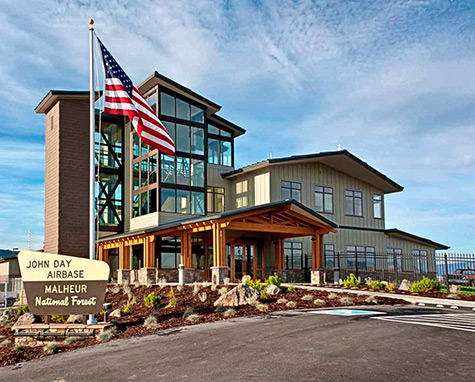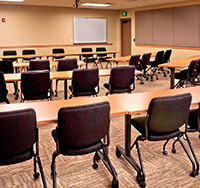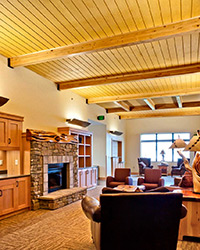
What sort of airport terminal would you expect a city of 2,000 to have? Would it even be called a “terminal?” Here’s what you might expect.
It would be tiny—1,100 square feet, to be exact—and would be called an FBO. The airport manager would have a closet-size office. Heat would circulate so poorly in winter that it would be the same as having no heat. Same for air conditioning in summer. That’s exactly what Olgilvie Field in John Day, Oregon, had. John Day is a city, not a person.
That was the office of Airport Manager Colin English. Now look at what he has. His office is on the second floor of a beautiful new, well-heated and well-air-conditioned $4.2 million palace with a beautiful view. A pilot lounge can be accessed anytime, even when the main building is closed. It has restrooms, showers, satellite TV, Internet, and a bunk room with two beds. A couple that landed after hours to escape a snowstorm stayed the night, quite comfortably. An innovative biomass heating plant costing only $300,000 and burning wood pellets left over from logging operations heats the building, saving $30,000 a year over conventional heating methods.
 The Oregon State University Extension office conducts evening classes there each month. County departments and the U.S. Forest Service meet there. Anniversary and baby showers are celebrated there, and recently a man came in with his daughter to consider the terminal for her wedding and reception. Pilots land there just to look.
The Oregon State University Extension office conducts evening classes there each month. County departments and the U.S. Forest Service meet there. Anniversary and baby showers are celebrated there, and recently a man came in with his daughter to consider the terminal for her wedding and reception. Pilots land there just to look.
“I have yet to see any other kind of rural airport like this. It is unique. I have seen regional and medium-size airports that don’t have anything like this,” English said.
The main runway was recently renovated and is 5,220 feet long. The crosswind runway is 4,500 feet. The runways and taxiways were improved by 2008 and 2009 projects.
John Day is not near anything. “Quite a bit of transient pilots flying Spokane to Sacramento and Boise to Portland stop here,” English said. “We’re meeting next week on getting a sandwich and coffee shop during the summer.” It has excellent snow removal capability and has only been closed one day since opening in September 2010. That was a December day when snow was coming down at three to four inches an hour.
There is no airline service. You still need to drive 3.5 hours to Redmond, Ore., to catch a regional flight. Boise, Idaho, and Bend, Ore., are also 3.5 hours away by car. So what is the secret to getting the sort of terminal this little community built?
 It helps to be friends with the U.S. Forest Service, and to live in a state that is generous with tax dollars. The U.S. Forest Service is a partner in the building and contributed an $800,000 matching grant, while Oregon contributed millions. The FAA contributed comparatively little.
It helps to be friends with the U.S. Forest Service, and to live in a state that is generous with tax dollars. The U.S. Forest Service is a partner in the building and contributed an $800,000 matching grant, while Oregon contributed millions. The FAA contributed comparatively little.
The partnership with the Forest Service is the first time such an agreement has been used, and now the government agency is using John Day as a model for the nation. It hopes to partner with other communities and states to share costs for the benefit of itself and the local community. The airport has 8,000 square feet of the building, while the Forest Service has 19,500 square feet.
Every time there is a Chamber of Commerce or other local group using the terminal for meetings, it is another $30 to $50 for the airport in rental fees. “It’s a new revenue stream,” English said. Meetings started immediately last September and are increasing steadily. There are 14 revenue-producing meetings in March.
“The main response from people who walk in is, their jaw drops, and they say, ‘Wow, I did not expect this,’” English said.

